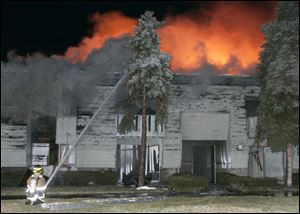
Apartment complex could lose U.S. funds
Site of fatal fire uses program to assist low-income renters
4/5/2012
A Feb. 6, 2006, fire at Hidden Cedars injured two people, destroyed a 16-unit building, and damaged another at the complex.
A recent fatal fire -- the latest in a string of serious fires at a Springfield Township apartment complex -- could cause the Hidden Cedars apartment complex to lose funding from a federal program that houses low-income people.
In 12 years, six fires -- four of them major -- have broken out at the Hidden Cedars condominium complex. The most recent blaze, on March 25, left two residents dead and about 30 adults and 39 children homeless.
Six of the complex's residents receive Housing Choice Vouchers, also known as Section 8 vouchers, according to the Lucas Metropolitan Housing Authority. Two of those residents were displaced by the fire.
In the Section 8 program, low-income residents are issued a voucher; the family can use the voucher to help pay for housing in a unit they choose where the owner agrees to participate in the program. The family then pays the difference between the rent charged by the landlord and the amount subsidized by the program. The subsidy is paid to the landlord directly by LMHA on behalf of the participating family.
At Hidden Cedars, LMHA pays a total of $2,537 monthly to two landlords, S&S Investment and KMAR LLC, for the six Section 8 residents there.
LMHA officials will examine federal Housing and Urban Development regulations to see whether they can continue to allow Section 8 recipients to use their vouchers at Hidden Cedars.
"That is a concern," LMHA Executive Director Linnie Willis said. "We've got to do that research and do it pretty quickly."
Mrs. Willis said she was especially concerned after The Blade reported Tuesday that the buildings appear to have been out of compliance with building safety standards. A review of the 1970 Ohio Building Code, which would have been in effect when Hidden Cedars was built in 1972, required fire-stopping in attic spaces that exceeded 3,000 square feet. Fire-stops are barriers intended to slow the spread of fire and compartmentalize its oxygen supply.
They don't prevent fires but slow their spread, limiting damage and giving residents more time to escape.
The agency must be careful in violating a right of choice for participants, however, Mrs. Willis said.
Part of the intent of the Section 8 program is allowing residents a chance to move to a neighborhood of their choice to offer low-income people greater opportunity. Typically there are fewer landlords willing to accept Section 8 tenants in Toledo's suburbs. The Web site gosection8.com lists no available rentals in Maumee, Holland, or Springfield Township. Mrs. Willis said if residents were forced to move, the agency would try to encourage them to find other landlords in that area to participate in the program.
Some of the complex's residents live there so their children can attend Springfield Local Schools, said Janika Clemmons. who lives in one of the remaining buildings. Ms. Clemmons, who does not receive a Section 8 voucher, said the fire has her and her two teenage sons on edge. "We pray going to bed," she said. "We pray waking up."
The Section 8 program is funded by HUD and administered locally by LMHA.
According to the housing authority, units in Building G, which was completely destroyed, were inspected Aug. 29 and June 24, 2011. Other units in Building B and Building E were inspected within the last several months. Hidden Cedars has been approved for residents to use Section 8 vouchers since 2004.
According to records from the Lucas County Auditor's Office, the majority of the condominiums in Building G are owned by Forty Hidden Cedars LLC and S&S Investment Co., though a handful are owned by individuals.
While the most recent fire was the result of arson, fire and building officials in Springfield Township said two factors contributed to the rapid spread of previous fires in the 1970s-era buildings: the lack of fire stops, which means that once flames reach the attic, they can spread rapidly; and the buildings were constructed of prefabricated modules stacked on top of each other, creating horizontal and vertical voids through which flames could move.
Fifteen fires have occurred at Hidden Cedars since 1998, according to incident reports provided by the Springfield Township Fire Department.
Some of those have been minor -- a cooking fire, a brush fire, a Dumpster fire. Others have been more serious, and at least four have been major blazes that destroyed entire buildings.
The last major fire before the one last month occurred Oct. 4, 2009, when an 18-unit building was destroyed, leaving 34 residents homeless and causing $2 million in damage. Prior to that, a Feb. 6, 2006, fire injured two people, destroyed a 16-unit building, and damaged another at the complex.
On July 7, 2000, another fire gutted a 20-unit building there.
Staff writer Tony Cook contributed to this report.
Contact Kate Giammarise at: kgiammarise@theblade.com or 419-724-6091.